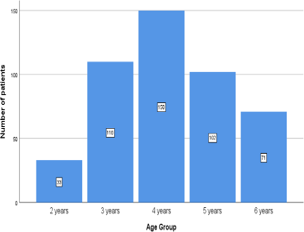Abstract
Success of any restoration depends on the material used and the skill of the operator. This study aims to compare the clinical efficiency of postgraduates of various years in placing stainless steel crowns in maxillary 1st molars and thereby finding how operator skills affect the placement by analyzing their grades. In this retrospective study the dental records of pediatric patients who had visited the dental hospital located in Chennai, Tamil Nadu, India from June 2019 to March 2020 were reviewed. Patients who underwent stainless steel crown placement of at least one primary maxillary 1st molar teeth under local or general anesthesia of 2-6 years of age by postgraduates were included in the study. Out of the 467 teeth treated 268 (57.38%) were of males and 199 (42.61%) females. The percentage of treatment done at various ages were at 2 years: 33(7.06%), 3 years: 110(23.55%), 4 years: 150(32.11%), 5 years: 102(21.84%), 6 years: 71(15.20%). The percentage of crowns placed by postgraduates of various years were 1st year postgraduates: 86(18.41%), 2nd year postgraduates: 170(36.40%), 3rd year postgraduates: 211(45.18%). Chi-square test was done and the association was found to be not significant( p-value = 0.139). The frequency of each tooth treated being primary right 1st molar: 164(35.11%), primary right 2nd molar: 56(11.99%), primary left 1st molar: 180(38.54%), and primary left 2nd molar: 67(14.34%). This data showed that the 3rd year postgraduates got the most number of high grades 211(45.18%). Chi-square test was done and the association was found to be significant (p-value = 0.000). There is a significant difference in the placement of stainless steel crowns among the various postgraduates. There was a gradual increase in the clinical performance with the 3rd years performing the best among the three years.
Full text article
Authors

This work is licensed under a Creative Commons Attribution-NonCommercial-NoDerivatives 4.0 International License.

